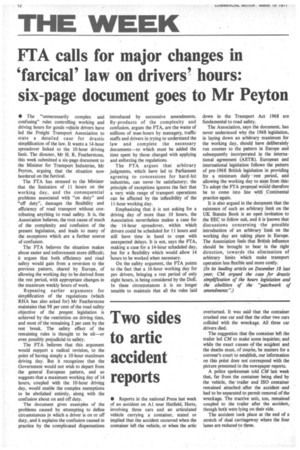VIA calls for major changes in 'farcical law on drivers' hours: six-page document goes to Mr Peyton
Page 14

If you've noticed an error in this article please click here to report it so we can fix it.
• The "unnecessarily complex and confusing" rules controlling working and driving hours for goods vehicle drivers have led the Freight Transport Association to state a detailed case for drastic simplification of the law. It wants a 14-hour spreadover linked to the 10-hour driving limit. The director, Mr H. R. Featherstone, this week submitted a six-page document to the Minister for Transport Industries, Mr Peyton, arguing that the situation now . bordered on the farcical.
The FTA has stressed to the Minister that the limitation of 11 hours on the working day, and the consequential problems associated with "on duty" and "off duty", damages the flexibility and efficiency of road transport without contributing anything to road safety. It is, the Association believes, the root cause of much of the complexity and confusion of the present legislation, and leads to many of the exceptions which are a further source of confusion.
The FTA believes the situation makes abuse easier and enforcement more difficult; it argues that both efficiency and road safety would gain from a reversion to the previous pattern, shared by Europe, of allowing the working day to be derived from the rest period, with appropriate changes in the maximum weekly hours of work.
Repeating earlier arguments for simplification of the regulations (which RHA has also asked for) Mr Featherstone maintains that 98 per cent of the road safety objective of the present legislation is achieved by the restriction on driving time, and most of the remaining 2 per cent by the rest break. The safety effect of the remaining rules is thought to be nil—or even possibly prejudicial to safety.
The FTA believes that this argument would support a radical revision, to the point of having simply a 10-hour maximum driving day. But it recognizes that the Government would not wish to depart from the general European pattern, and so suggests that a maximum working day of 14 hours, coupled with the 10-hour driving day, would enable the complex exemptions to be abolished entirely, along with the confusion about on and off duty.
The document gives examples of the problems caused by attempting to define circumstances in which a driver is on or off duty, and it explains the confusion caused in practice by the complicated dispensations introduced by successive amendments. By-products of the complexity and confusion, argues the FTA, are the waste of millions of man-hours by managers, traffic staffs and drivers in trying to understand the law and complete the necessary documents—to which must be added the time spent by those charged with applying and enforcing the regulations.
The FTA argues that arbitrary judgments, which have led to Parliament agreeing to concessions for hard-hit industries, can never , be satisfactory; the principle of exceptions ignores the fact that a very wide range of transport operations can be affected by the inflexibility of the 11-hour working day.
Emphasizing. that it is not asking for a driving day of more than 10 hours, the Association nevertheless makes a case for the 14-hour spreadover, within which drivers could be scheduled for 11 hours and still have time in hand to cope with unexpected delays. It is not, says the FTA, making a case for a 14-hour scheduled day, but for a flexibility which would allow 14 hours to be worked when necessary.
On the safety argument, the FTA points to the fact that a 16-hour working day for psv drivers, bringing a rest period of only eight hours, is being considered by the DoE. In these circumstances it is no longer tenable to maintain that all the rules laid down in the Transport Act 1968 are fundamental to road safety.
The Association, says the document, has never understood why the 1968 legislation, in laying down an arbitrary maximum for the working day, should have deliberately run counter to the pattern in Europe and subsequently incorporated in the international agreement (AETR). European and international legislation follows the pattern of pre-1968 British legislation in providing fOr a minimum daily rest period, and allowing the working day to stem from this: 'To adopt the FTA proposal would therefore be to come into line with Continental practice again.
It is also argued in the document that the existence of such an arbitrary limit on the UK Statute Book is an open invitation to the EEC to follow suit, and it is known that discussions concerning the possible introduction of an arbitrary limit on the working day are taking place in Europe. The Association feels that British influence should be brought to bear in the right direction, towards the elimination of arbitrary limits "which make transport operation less flexible and more costly.
(In its leading article on December 18 last year, CM argued the case for drastic simplffication of the hours legislation and the abolition of the "patchwork of amendments')




























































































